HTIRC E-Newsletter
Fall/Winter 2021
Volume 14 Issue 1
Articles in this issue
- Woodland Owners – Get a Head-Start on Your 2021 Tax Return
- HTIRC Annual Meeting Highlights Potential for Digital Forestry
- Remote Sensing to Detect Forest Pests
- Sustainability of Eastern Hemlock (Tsuga canadensis) in Indiana
- Forest Service Scientists Mentor Summer Interns
- Jim McKenna retires from U.S. Forest Service, NRS-14
- Stay Up-to-date with HTIRC Activities and Products
Woodland Owners – Get a Head-Start on Your 2021 Tax Return
By Lenny Farlee, Extension Forester
Many forest landowners miss opportunities to save on their income and property taxes. Even accountants and tax experts may not be aware of some of the provisions covering woodland ownership, timber sales income, and reforestation expenses. It can pay dividends to become familiar with some of the tax programs and policies that might save you money and inform how you execute your woodland management in the future.
Several states offer programs that reduce property tax liability for woodland owners who meet certain requirements and enroll in and abide by the regulations of state forestland programs. These programs vary by state, but may provide a variety of benefits, including property tax liability reduction, forest management plans, and management assistance. Contact your state forestry or natural resources agency to see what may be available and if it meets your property management goals.
The sale of timber will generally trigger a tax bill, but knowing how timber is taxed and how to manage your tax liability can save you significant money in some cases. Your professional forester can help you navigate the tax issues related to selling timber, but becoming familiar with the ways you can manage your tax liability can help you plan now and into the future.
The Woodland Stewards Regional Extension Program for Landowners was developed by a collaborative team of forestry Extension professionals from eleven different organizations. This is the fourth year of the series and other webinars from the current and past series can be accessed on the Webinar Portal.
A series beginning on January 18th will provide an introduction to the tax management topics you may encounter as a forest land owner. Visit this website to sign up for these programs.
Forestry Taxes: Learn, Plan & Save Money – https://sref.info/woodland-stewards/2022
All webinars will be recorded and will be available a few days after the presentation, at the same link.
The National Timber Tax website https://www.timbertax.org/ is another resource to learn more about the tax rules and opportunities landowners may utilize. This site contains abundant resources, decision tools, and references to help you with your tax management planning.
Finally, keep good records of your expenses and activities. Tax law and policy can change, but having good records can help you adapt and support your management program.
back to the top
HTIRC Annual Meeting Highlights Potential for Digital Forestry
On October 15, 2021 the HTIRC Advisory Committee, stakeholders and staff met at the John S. Wright Center for an annual meeting to share progress on the goals for HTIRC and provide an opportunity for the committee and stakeholders to provide feedback on our programs and products, as well as suggest new or overlooked opportunities we could explore. Presentations were provided on the development of a new strategic plan, extension and engagement activity, and HTIRC engagement with the Center for Advanced Forestry Systems, a National Science Foundation Industry/University Cooperative Research Center that bridges top academic forestry research programs with industry members to solve problems facing our nation’s planted and natural forests.
In the afternoon, one of the field tour topics was the potential uses of new and developing technologies in digital forestry. Several data collections platforms were demonstrated. A simple but very accurate and efficient diameter-measuring camera and associated software could greatly reduce the time needed to inventory tree plantations. Multiple drone platforms can carry cameras and scanners to measure and detect several forest characteristics including tree height, crown diameter, and evidence of stress, insects or disease. A prototype LiDAR (laser imaging, detection, and ranging) backpack was demonstrated, which can capture and create a digital point-cloud for forest measurements from the ground.
Each of these technologies and more are part of the new Plant Sciences 2.0 Integrated Digital Forestry Initiative at Purdue University, with several HTIRC funded investigators participating.
Learn more about the people and HTIRC funded projects behind the new Integrated Digital Forestry Initiative: https://ag.purdue.edu/digital-forestry/
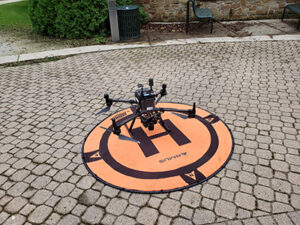
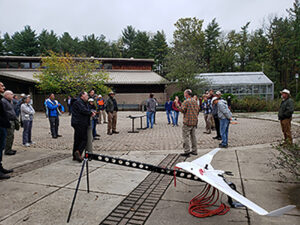
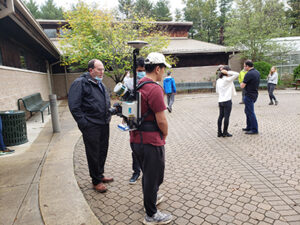
back to the top
Remote Sensing to Detect Forest Pests
Dr. John Couture, Associate Professor, Ellie Joll, M.S. Student
Spotted lanternfly (SLF) is a phloem-feeding planthopper native to Asia that has made its way to the United States and attacks vineyards, orchards, and forest trees. First found in Pennsylvania in 2014, it has spread throughout the northeast and was reported in southeastern Indiana in 2021. Understanding how SLF moves both locally and over long-distances is important information to have as we prepare to deal with this invasive insect. Fortunately, we can see how SLF affects trees by looking at tree canopies. Remote sensing approaches have been used to detect damage in forests caused by pests and pathogens and also can identify areas of higher habitat quality that might be more attractive or support larger populations of pest insects. My work focuses on how changes in tree canopies are associated with spotted lanternfly infestations. By identifying these changes, we might be able to not only detect SLF infestations quickly and efficiently to prevent further spread, but predict where SLF is most likely to invade.

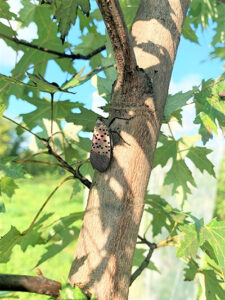
More information about spotted lanternfly
Learn more about remote sensing as a forest management tool
back to the top
Sustainability of Eastern Hemlock (Tsuga canadensis) in Indiana
Summer Rathfon, Dr. Michael Jenkins, Dr. Keith Woeste
Summer Rathfon, a graduate student at Purdue University, has spent the past year researching the regeneration and long-term outlook for Eastern Hemlock in Indiana. Eastern hemlock is an evergreen species native to Indiana, but uncommon here. State Parks and natural areas, such as Shades State Park in Montgomery County, IN, and parts of the Hoosier National Forest are the best place to see Indiana’s eastern hemlock.
Although eastern hemlock (Tsuga canadensis) is a foundational tree species in much of Appalachia and the North Woods. Recent visitors to Great Smoky Mountains National Park probably noticed that many of the hemlocks there are dying. The eastern hemlock there is being killed by an exotic insect called Hemlock wooly adelgid (HWA). Fortunately, HWA has not arrived in Indiana – at least not yet. In Indiana, eastern hemlock survives in small, isolated pockets, usually on cool, steep, north-facing slopes. These patches of eastern hemlock are remnants of what was (tens of thousands of years ago) a large, continuous forest containing eastern hemlock that covered the eastern United States. Nowadays, competitive hardwood species dominate the forest landscape of Indiana, so eastern hemlock is not an important timber species, as it once was in the eastern forest. Hemlock remains ecologically important, however, providing distinctive cover and habitat for numerous birds, amphibians, plants, and even aquatic stream-dwelling species that prefer cool water in the shade of hemlock-lined streams.
Because Indiana hemlock populations are small and separated from each other and from trange of the species, Indiana’s eastern hemlock may contain unique genetic variability that will be of use in fighting HWA invasion. Unfortunately, Indiana’s hemlocks are also at risk of low genetic diversity because their population size is so small in many areas where they are found. Lack of genetic diversity can lead to inbreeding, low seed viability and poor regeneration, a problem noted in some areas of Indiana containing hemlock.
In northern habitats, deer prefer hemlocks for winter browse and they frequently congregate under hemlock during the winter months. While this phenomenon does not occur in Indiana, deer may still have a negative effect on hemlock regeneration. Some studies have found that deer prefer to rub their antlers on young trees that contain high concentrations of aromatic compounds and have soft bark. Eastern hemlock trees in Indiana have these characteristics, so deer may be putting additional stress on the already reduced populations.
Our research, supported in part by Purdue University, the USDA Forest Service, and the Indiana Academy of Sciences, aims to understand the genetic diversity of Indiana’s hemlocks, how their diversity affects their reproduction, and whether injury from deer is constraining hemlock’s ability to maintain self-sustaining populations in Indiana. As mentioned above, Rathfon spent the past year collecting samples of needles and cones from representative eastern hemlock populations in Indiana, measuring tree size and abundance, and observing injury from deer rub. Now, working in the genetics laboratory at Purdue’s Department of Forestry and Natural Resources, she is using DNA extracted from the needle samples to understand how much genetic diversity is maintained in the stands she visited. By germinating the seeds from the cones she collected, she expects to gain insight into whether inbreeding and small population sizes are affecting the reproductive health of the stand. She expects to publish a full report of her findings in about a year.
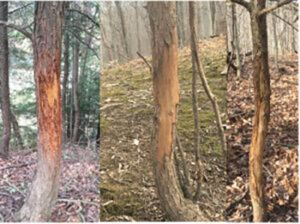
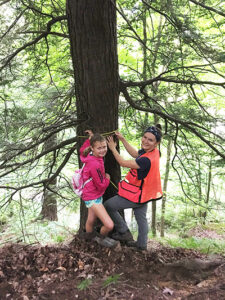
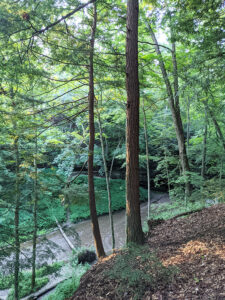
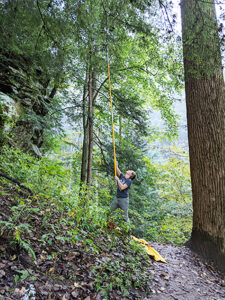
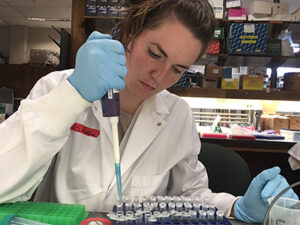
Selected References
- Anderson, R., & Loucks, O. 1979. White-Tail Deer (Odocoileus virginianus) Influence on Structure and Composition of Tsuga canadensis Forests. Journal of Applied Ecology, 16(3), 855-861. doi:10.2307/2402859
- Beane, N. R., Heitzman, E., & Schuler, T. M. 2010. Stand dynamics of an old-growth eastern hemlock-hardwood forest in West Virginia. Natural Areas Journal, 30(1), 64-72.
- Ellingson, E., S. McNamara, J. Bradeen, and S.C Hokanson. 2018. The genetic diversity of disjunct populations of eastern hemlock (Tsuga canadensis) in Minnesota. Acta Horticulturae 1191: 225-234.
- Friesner, R.C. and J.E. Potzger. 1936. Soil moisture and the nature of the Tsuga and Tsuga-Pinus Forest Associations in Indiana. Butler University Botanical Studies 3: 207-209.
- Hobbs, C. and K. Clay. “Disjunct eastern hemlock populations of the Central Hardwood Forests: ancient relicts or recent long distance dispersal events? Pp. 18-21. In 10th Mammoth Cave Research Symposia, February 14, 2013.
- Potter, K.M., R.M. Jetton, W.S. Dvorak, W.S. et al. 2012. Widespread inbreeding and unexpected geographic patterns of genetic variation in eastern hemlock (Tsuga canadensis), an imperiled North American conifer. Conservation Genetics 13: 475–498.
back to the top
Forest Service Scientists Mentor Summer Interns
By Dr. Shaneka Lawson
This past summer, Forest Service scientists Drs. Shaneka Lawson and Anna Conrad mentored interns participating in the Research and Extension Experiential Learning for Undergraduates (REEU) program. The REEU program is a field and laboratory-based, natural resource science internship program designed to address research questions related to the biodiversity of ecosystems within a highly agricultural landscape. The overarching objective of the program is to help participants develop technical, critical thinking and mentoring skills while providing career development opportunities. The 8-week endeavor began in early May before culminating in the display of summer project results. The students shared posters of their research projects and gave 20 minute presentations to an audience filled with peers, program supporters, and potential employers (Figure 1).
The project initiated and developed by the interns working with Lawson and Conrad was entitled “Effects of Soil Characteristics and Tree Physiology on the Severity of Butternut Canker Disease”. This research project aimed to identify variability in simple soil characteristics and tree physiology within butternut trees displaying specific butternut canker disease (BCD) severity rankings (Figure 2). As the project progressed, more than 3,000 butternut trees within the Martell forest area were rated for BCD severity based on a scale established by the Hardwood Tree Improvement & Regeneration Center (HTIRC). Trees were classified as susceptible, intermediate, or resistant before subsets were randomly selected for collection of stem and leaflet samples (Figure 3). Soil characteristics such as moisture content and pH were measured and compared across an upland and bottomland site. Stem cross-sections were stained and chlorophyll leaching was measured in leaves from trees that differed in disease severity.
While distinct differences in soil characteristics were observed between the sites, follow-up research will be done to confirm variability observed in chlorophyll leaching and histochemical staining of stem cross-sections. A research note was also generated by the interns working closely with Lawson and Conrad. This will be further edited and submitted for publication at a later date.

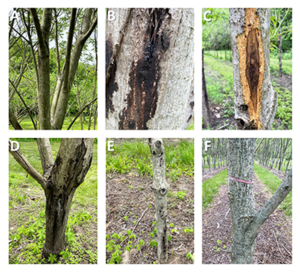
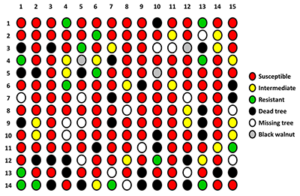
back to the top
Jim McKenna retires from U.S. Forest Service, NRS-14
Operational tree breeder Jim McKenna retired from the USDA Forest Service in July 2021 and stepped down from his role at the HTIRC, which he had held since 2002. His research expertise included plant propagation, genetic testing, and plantation/seed orchard establishment.
Jim worked as part of a team in the USDA Forest Service research unit at Purdue, and along with other Purdue researchers and many partner organizations, focused on developing improved planting stock of fine hardwood trees. The primary species for improvement are black walnut, black cherry, and northern red oak to provide landowners with trees that are adapted to their area, are vigorous, uniform, and have good timber quality.
Jim also had a passion for breeding disease resistance in two threatened native tree species: butternut and American chestnut, and more recently was studying resistance of black walnut to thousand cankers disease.
He was instrumental in establishment of hardwood tree plantings for the HTIRC in Indiana and across the nation, installing or assisting with over 170 plantings totaling several hundred thousand seedlings, improvement and breeding work which can continue for many years due to his efforts. Jim retired from HTIRC to join the private sector, and we wish him well in his next chapter.
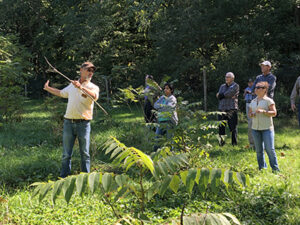

back to the top
Stay Up-to-date with HTIRC Activities and Products
The staff of the HTIRC are working on a great variety of projects and programs in many different areas of inquiry. To find out more about the research, discoveries, publications and media available, please check out these resources.
The HTIRC website https://htirc.org/ is the portal to access many of the projects and products on which we are working. The Annual Report https://htirc.org/annual-report/ provides a review of the HTIRC-funded research projects, our efforts in tree breeding, extension and engagement, and education of the next generation of scientists. You can also access extension publications, identification and management videos, and past issues of the email newsletter as well.
The HTIRC is also a Research Work Unit of the US Forest Service Northern Research Station. Recent research publications from the Forest Service scientists working at the HTIRC can be accessed at this US Forest Service Northern Research Station website: https://www.nrs.fs.fed.us/units/htirc/

back to the top
